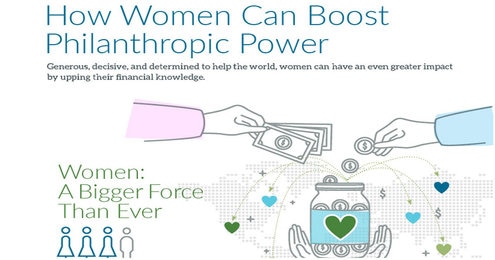
The Boomer Woman’s Guide to Better Giving
Useful tips for a generation that’s already discovered giving now is better than it used to be.
Your giving is focused and strategic—you zero in on what you really care about and feel good about what you’re able to give. That’s the theme from Women and Giving, a Fidelity Charitable report detailing the giving habits of two generations of women, Baby Boomers and Millennials.
From the start, our results show an interesting contrast: Boomers are much more satisfied with giving. Seventy-two percent of Boomers reported feeling this way, compared with only 55 percent of Millennials. That satisfying feeling is solidly rooted in one of your generation’s key giving strengths—starting with strategy. While you’re champions for addressing causes such as hunger and access to nutritious food or treating or finding cures for disease, you’re thoughtful about how you do it. Fifty-two percent said your giving is very strategic, compared with 29 percent of Millennials.
You’ve learned what’s really important to you and are putting your time and resources there. At the same time, you’re less confident about some of the financial aspects of giving. And you may be missing out on some soul-satisfying opportunities to connect with family and community around giving.
We can help. Put the tips in this guide to work and we’re sure you’ll find giving to be even more fulfilling. And you’ll make a greater impact, no matter what causes you care about or how much you have to give.
Give your giving plan a checkup
A majority of you are already several steps ahead of the game in making a greater impact, because you know what you care about most. Only 33 percent of Boomers report giving to a wide variety of causes, choosing instead to focus on a few key areas that matter deeply to you. You may even have a formal mission statement in place outlining the purpose of your giving, which is one of the best ways to focus your resources. Speaking of resources, you also feel good that you’re giving as much as you’d like to be—a contrast with Millennials who feel much more torn about how to allocate their resources. With this great foundation, a little housekeeping can do wonders to make your giving have even greater impact.
Take it to the next level:
Be sure your giving lines up with what you care about. Are you allocating your resources in the way you truly want to? Take a look at your giving history from the last couple of years. Does it line up with your mission? For example, consider access to basic health services, addressing hunger, and finding cures for disease—all among the top five issues Boomers told us you care about most. If these causes were at the top of your list, you’d want a majority of your giving—70 percent to 80 percent—going there. If that’s not the case, it’s probably time to realign. This is just as true of the time you spend volunteering as it is for your financial support—your time is precious, and you should spend it on the organizations most important to you.
Extend your time horizon. You have some charities and organizations that you really love and give to every single year. Those donations add up over time, and you might as well be as strategic as possible about them. As you think ahead over the next five, 10 or 20 years, what would you like to do for those organizations? What does the organization really need to operate at the highest possible level? Our worksheet for creating a charitable action plan offers a menu of ideas that you can choose from for ways to make a greater impact over time.
Don’t hesitate to reach out to the nonprofit, tell them about your plan to support them, and ask what would be the most valuable way to direct the gift. They’ll be able to plan better if they know they can count on your support, and you’ll feel even better about the donation knowing it’s going to what is most important to the organization.
Find deeper joy by involving others

More than two-thirds of you describe yourselves as highly engaged in giving, but you’re less likely than your Millennial counterparts to have talked about it on social media or to participate in a Giving Circle. Yes, giving can be private and personal—but it can also be a wonderful way to engage with like-minded peers, forge deeper connections with multiple generations of your family and create a meaningful social outlet. You might even be able to create better outcomes for the organizations you care about.
Take it to the next level:
Join a giving circle to dial up your impact. Here’s how giving circles work: Everyone contributes her or his own money, which is pooled together. Then, as a group, you decide how to give the funds on an ongoing basis. You may be able to find and join an established giving circle in your area—or you can start your own with friends and family. Arrange regular meetings or simply organize the details through email or a Facebook group. It makes giving social and fun, and with more than one person involved, it gives you the chance to make a much more sizable contribution to a charity than possible individually.
Be a voice for the organizations you love. Only 30 percent of Boomers report encouraging others to give to the same causes you do, while 51 percent of Millennials make it a point to spread the word in their circles. In fact, more than 70 percent of you said you don’t talk with others about the organizations you support at all. But don’t forget that most causes could use more advocates. There are lots of ways to get the word out in a low-key way that won’t make anyone uncomfortable.
Simply posting photos from a charity event, or even a relevant news article on Facebook, is a way to inform and possibly inspire others who may be interested in the very same causes but didn’t know where or how to help. Always post the full name of the charity you’re working with and, if possible, include a website where others can join the cause, and you’ve done a good deed to get the word out.
Keep giving at the heart of your relationship. Nearly 70 percent of married or partnered Boomer women have discussions about giving with their other half, and only rarely disagree about where to give. But only a sliver, 16 percent, of your generation say that discussing giving is a way to deepen your relationship. This was considerably smaller than Millennials at 46 percent. This could be because your relationships are already plenty deep—or because giving back provides a valuable opportunity for each of you to pursue separate interests. But at the same time, you may find even greater shared inspiration and delight if you go beyond discussion and plan some projects together, whether a more significant gift to a nonprofit you both care about or a shared volunteering opportunity.
Get your children or your grandchildren involved. One of the most rewarding ways to boost the effects of giving is including your kids or grandkids. Yes, planting those philanthropic seeds now may lead to a spirit of generosity for generations to come, but working as a team for good is simply a lovely way to spend time together right now. Depending on the life stage of the family members you most want to engage—and how your family works best together—you may want to create something formal, like a family giving circle where everyone in the family decides to support some common charities. Or you may want to keep it casual and occasional, like organizing a family bonding day where you volunteer to help clean up a local park and then all go out to dinner to celebrate your good work. If this idea sounds intriguing, start getting ideas with 10 ways to involve kids in giving, at any age (including adults!).
Stretch your giving dollars with financial savvy
If you feel more confident in your ability to choose a wonderful charity to support than you do in making decisions related to the finances of giving, you’re not alone. Just 40 percent of women say they feel confident about decisions related to tax strategies or methods to use for giving, for example. But that lack of confidence could be getting in the way of your making decisions that could be best for your own financial situation—and that could potentially help you make a substantially bigger impact through your giving.
Take it to the next level:
Get familiar with some new options. Your financial situation today probably looks a lot different than it did when you were in your 20s. But your giving may look very similar—you write a check to a charity and keep records of the gift for tax time. You may want to investigate whether one of the tips in this brief guide to smart charitable tax strategies is worth a try instead. For example, if you have a taxable investment account, you might try donating appreciated securities (mutual funds, stocks and bonds) directly to charity instead of cash. The full value of your appreciated securities goes straight to charity.
Not only can this type of gift keep your cash free for other uses, but it may also provide a capital gains tax savings that may mean a difference of up to 23 percent more to charity than if you were to sell the securities yourself and donate the proceeds. Many charities accept securities donations. Or you can contribute them to a donor-advised fund, a dedicated account for charitable giving, which can make it simple to make a single stock donation and support multiple charities.
Bring your financial advisor in on your plans. You didn’t get where you are by being afraid to ask questions—and this may be a case where it’s smart to ask. Be sure to put charitable giving on the list of things that you ask about when you consult your CPA, investment advisor, or tax or estate attorney. Your advisor may be able to help you identify the contribution strategies that will most help you maximize your tax deductions and the amount you have available to donate, whether that’s a qualified charitable distribution from an IRA or a donation of securities. They can also help you structure a multi-year gift in the most tax-smart way, ensure that your charitable priorities are appropriately addressed in an estate plan, or set up a charitable giving vehicle. But unless you ask, it may never come up.
Ready to take your giving to the next level? Start with our free four-step guide. From a mission statement template you can use as an individual donor, couple or a group, to the most important questions to ask a nonprofit, we’ll help you make your mark.
How Fidelity Charitable can help
Since 1991, we have been a leader in charitable planning and giving solutions, helping donors like you support their favorite charities in smart ways.
Or call us at 800-262-6039



